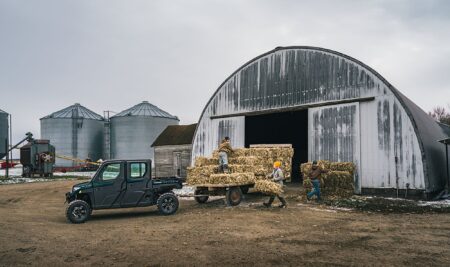Soybean emergence is underway across much of the country, with 15 of the 18 top soybean-growing states reporting emergence as of the week ended May 4, 2025. According to USDA’s Crop Progress report released Monday, 7% of the national soybean crop had emerged. That’s ahead of the five-year average of 5%, but slightly behind the 8% reported at this time last year.
Here’s a closer look at the soybean crops in Michigan, North Dakota, and South Dakota where farmers have yet to report soybean emergence.
Michigan
Despite above-average planting progress, soybean seedlings have yet to break the surface in Michigan, as of the week ended May 4.
The Michigan five-year average for soybean emergence at this point in the season is 1%. Last year at this time, 3% of the state’s soybeans had already emerged. Farmers had 4.5 days suitable for fieldwork during the week, contributing to some planting momentum, but emergence has been delayed by cooler soil temperatures and inconsistent weather.
Eric Anderson, Soybean Educator with Michigan State University Extension, said conditions are beginning to shift. While nothing had emerged as of the USDA report’s cutoff date, he said fields are now starting to show signs of progress.
“Even if somebody got planted back in the middle of April, we’re just starting to hit those 90°F growing days needed for emergence,” Anderson said. “Everything that’s been planted, I would expect it to emerge by the end of next week. Once our soil temps start to hit 60°F, those beans should be up and out of the ground in 7–10 days.”
Soil temperatures have hovered near the threshold for emergence in recent weeks, and although much of the state has technically been drier than average, persistent light rains have limited planting in some areas.
“It’s been a pretty wet season–not heavy rains, just annoyingly constant amounts every week,” Anderson explained. “It really depends where you’re at in the state and what kind of soil you have.”
Looking ahead, with warmer, sunnier conditions forecasted and soils warming, Anderson expects emergence numbers to climb significantly in the next USDA report.
North Dakota
North Dakota farmers did not report soybean emergence the week ended May 4. This is consistent with last year at this time and the five-year average for this point in the season.
The state saw 4.6 days suitable for fieldwork last week, allowing planting to move forward. With 10% of soybeans in the ground, soybean planting is ahead of the five-year average of 2%. Last year at this time, just 3% of the North Dakota soybean crop had been planted.
Emergence is expected to begin as temperatures gradually rise and soil conditions improve.
South Dakota
South Dakota also reported no soybean emergence, matching both last year at this time and the state’s five-year average.
With 4.5 days suitable for fieldwork the week ended May 4, producers have made planting progress, though emergence has yet to begin. USDA said a quarter of the South Dakota soybean crop had been planted in its latest Crop Progress Report. That’s ahead of the five-year average of 9%.
Other States
While Michigan, North Dakota, and South Dakota have yet to see soybean emergence, most other top-producing states have begun to report progress. Southern states lead the way, with Louisiana at 57%, Mississippi at 48%, and Arkansas at 38%. In the Midwest, Illinois (10%) and Iowa (5%) are ahead of average, while Indiana and Ohio trail their respective five-year averages slightly. North Carolina also stands out with 14% emerged, well above its typical pace.


:max_bytes(150000):strip_icc()/WheatField-CloseUp-2000-bc79406da4004a2d94bcb2c32153cc3a.jpg)
:max_bytes(150000):strip_icc()/102382793_soybeans-1a81c6603895423a8c6518aeefaa2b19.jpg)
:max_bytes(150000):strip_icc()/48671043887_7bb824daff_o-ea6663a7cacb4a7fa70d7b9a5af1f1fa.jpg)


:max_bytes(150000):strip_icc()/Soybeans_MayEmergeKS-57c5e34411884a2fafb5a17d8a07224f.jpg)


:max_bytes(150000):strip_icc()/WebMedium_JPG-2025-orv-family-image-00307-27c767eba092415c9f7b4751603e7840.jpg)